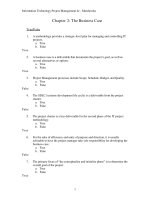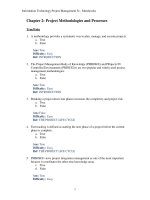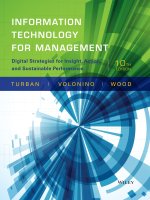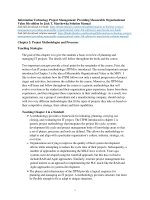Lecture Information technology project management - Chapter 9: Project communications management
Bạn đang xem bản rút gọn của tài liệu. Xem và tải ngay bản đầy đủ của tài liệu tại đây (282.79 KB, 32 trang )
Chapter 9:
Project Communications
Management
adopted from PMI’s PMBOK 2000 and
Textbook : Information Technology Project Management
1
Contents
• Importance of Good Communications
• Project Communications Management Processes
– Communications planning (planning phase)
– Information distribution (executing phase)
– Performance reporting (control phase)
– Administrative closure (control phase)
• Creating a stakeholder analysis
Chapter 9
2
Importance of Good Communications
• The greatest threat to many projects is a failure to
communicate
– Our culture does not portray IT professionals as being good
communicators
– Research shows that IT professionals must be able to communicate
effectively to succeed in their positions
– Strong verbal skills are a key factor in career advancement for IT
professionals
• covering processes to ensure timely development,
collection, disseminations, storage, and disposition of
project information.
– major output is the communications management plan.
Chapter 9
3
Project Communications
Management Processes
• There are 4 processes in Project Communications
Management
– Communications planning (planning)
• determining the information and communications needs of
the stakeholders
– Information distribution (execution)
• making needed information available in a timely manner
– Performance reporting (control)
• collecting and disseminating performance information
– Administrative closure (closing)
• generating, gathering, and disseminating information to
formalize phase or project completion
4
Communications Planning
• 14th of 21 planning phase process
• incorporates all planning required to ensure
timely and appreciate development, collection,
dissemination, storage, and disposition of project
information.
• Every project should include some type of
communications management plan, a document
that guides project communications
• Creating a stakeholder analysis for project
communications also aids in communications
planning
Chapter 9
5
Inputs to Communications
Planning
• Communications requirement
– include who needs what type of information, when they need the
information, how to distribute the information (i.e. who, what,
when how)
• Communications technology
– methods and tools used to transfer information among
stakeholders
– facetoface conversation, knowledge repository database, online
schedules, email, videoconference, voice mail, stream video,
newsletters and web sites.
• Constraints
– restriction that affect the performance of the project.
• Assumptions
– factors that for planning purposes
6
Tools and techniques
• Stakeholder analysis
– provides the methods and techniques to
determine a systematic and logical view of the
information requirements of stakeholders, and
how to meet those needs.
7
Outputs from Communications
Planning
•
Communications management plan (CMP)
– An evolving document and a subsidiary component of the project plan,
the CMP describes how to handle all communication on the project
– It can be formal or informal, detailed or highlevel, depending on the
needs of the project.
•
CMP Contents
– A description of a collection and filing structure for gathering and
storing various types of information
– A distribution structure describing what information goes to whom,
when, and how
– A format for communicating key project information
– A project schedule for producing the information
– Access methods for obtaining the information
– A method for updating the communications management plans as the
project progresses and develops
8
Information Distribution
• 4th of 7 executing phase process
• involves making information that stakeholders
need on a timely basis
– Getting the right information to the right people at the
right time and in a useful format is just as important
as developing the information in the first place
• By properly executing the communications
management plan
– using the information retrieval and distribution tools
– responding to unexpected requests for information
– ensure all stakeholders have the information they
need.
Chapter 9
9
The Impact of the Number of People on
Communications Channels
10
Inputs to Information
Distribution
• Work results
– results of activities performed to accomplish the
project. Information on work results – completed and
incomplete scheduled assignments and deliverables,
actual and committed budget cost, how QA standards
map to the result….
• Communications management plan (CMP)
– describe all communication on the project is handled.
• Project plan
– formal, approved document used to guide project
execution and control.
11
Tools and techniques
• Communications skills
– skills involving information exchanges. They are also part of the
general management skills.
• Information retrieval system
– tools in information distribution process
• simple paper files, bound notebook, or they can be stored
electronically as files or in a database
– Retrieval systems are either filing system or software.
• Commercial products such as Lotus Notes and Microsoft SharePoint
are examples of applications software.
• Info distribution methods
– distribution system (tools) include project meetings,
correspondence, databases stored in a data warehouse, and video
or audio conferences.
12
Outputs from Information
Distribution
• Project records
– organized for easy access
• includes correspondence, documents, and memos
– Team will keep their own personal records for their assigned
areas
– Their personal records are often more detailed than the official
project records.
• Project reports
– formal reports on status and issues
• Project presentations
– describe how the reports and records are presented to
stakeholders
– formal or informal. A great deal of a project manager’s job
13
Performance Reporting
• 6th of 8 controlling phase process
– collecting and distributing information to stakeholders on how
the project is performing
• Performance reporting keeps stakeholders informed about
how resources are being used to achieve project
objectives
– This process involves progress reports, status reports, and
forecasts.
– Status reports describe where the project stands at a specific
point in time
– Progress reports describe what the project team has accomplished
during a certain period of time
– Project forecasting predicts future project status and progress
based on past information and trends
– Status review meetings often include performance reporting
Chapter 9
14
Inputs to Performance Reporting
• Project plan
– formal, approved document used to guide project execution and
control.
– includes subsidiary plans such as the communications plan, risk
management plan, and quality plan. The plan sets a baseline to
measure progress.
• Work result
– results of activities performed to accomplish the project.
Information on work results – completed and incomplete
scheduled assignments and deliverables, actual and committed
budget cost, how QA standards map to the result….
• Other project records
– other documents such as blueprints, technical documents, or
specifications documents.
15
Tools and techniques
• Performance reviews
– project meetings are held to evaluate status and progress.
• Variance analysis
– compares results to planned results. Generally, the analysis is
cost and schedulerelated.
• Trend analysis
– examines project results over the dimension of time to see if
pattern show performance improvement or deterioration.
• Earned value analysis
– Integrates scope, cost and schedule measures. It compares actual
results to planned result. Calculations are based on three key
measures: Planned value, Actual cost, Earned value.
• Info distribution tools & techniques
– includes all the tools and technique mentioned in Information
16
distribution process.
Outputs from Performance
Reporting
• Performance reports
– contain organized and summarized results of project
reports, correspondence, documents, and memos
– If possible, use charts and graphs to summarize
information
– Some key documents are status report, progress
report, trend report and forecast report.
• Change requests
– ask for modifications to some deliverable or objective
– These formal documents can also involve changes to
a contract, even include contract termination.
17
Administrative Closure
• 1st of 2 closing phase process
• A project or phase of a project requires closure
– closing the administrative functions takes place at the
end of the project.
– Because projects are temporary, project closure
briefings and lessonslearned documents provide
important feedback
– They keep valuable knowledge inside the organization
and contribute to improvements in the next cycle of
project.
Chapter 9
18
Inputs to Administrative Closure
• Performance measurements documents
– includes all the performancerelated documents used to guide,
record, and analyze project planning, execution and control
– Other documents such as status, progress, and forecast report
• Product documentation
– show result of activities performed to create the product or
service that the project was chartered to achieve
– These include plans, technical documents, design documents,
specifications, blueprints, drawings, and electronic files.
• Other project records
– other related documents
19
Tools and techniques
• Performance reporting tools and techniques
– provide a feedback loop, solving the information needs of the
various stakeholders and showing the interaction of all the tools
used during the Performance Reporting phase just described.
– Tools and techniques include performance reviews, variance
analysis, trend analysis, and earned value analysis.
• Project reports
– formal reports on status and issues
• Project presentations
– describe how the reports and records are presented to
stakeholders.
– It can be formal or informal
– A great deal of a project manager’s job involves doing this
stakeholder presentation.
20
Outline for a Final Project Report
Chapter 9
21
Sample Template for a Project
Web Site
Chapter 9
22
Outputs from Administrative
Closure
• Project archives
– this is the longterm storage of all project activity records
– The information should be complete and indexed for easy
retrieval.
• Formal acceptance
– confirms by customer by formally accepts the completion of the
project
• all requirements have been fulfilled
– These require may include staff performance reviews,
budget/cost reports, and lessonslearned documents.
• Lessons learned
– includes detailed information on how common and usual project
events were resolved.
– part of the organization’s knowledge base so the information can
23
be applied to future projects.
Suggestions for Improving Project
Communications
•
•
•
•
Manage conflicts effectively
Develop better communication skills
Run effective meetings
Use templates for project communications
Chapter 9
24
Conflict Handling Modes, In Preference
Order
• Problemsolving
– also known as confrontation
– directly face a conflict and resolve it at once
• Compromise
– use a giveandtake approach
• Smoothing
– deemphasize areas of differences and emphasize areas of
agreement
• Forcing
– the winlose approach
• Withdrawal
– retreat or withdraw from an actual or potential disagreement
Chapter 9
25









